Bulletin – December 2010 Developments in Emerging Equity Markets
Abstract
The size of equity markets in emerging economies increased very significantly over the past decade both in absolute terms and as a share of global equity markets. Emerging equity markets also account for a rising share of global equity issuance. In large part, this growth has been spurred by strong economic growth and financial development within these economies. During the global financial crisis, as risk aversion increased, emerging equity markets' share of global market capitalisation fell sharply, though it has since more than recovered.
Introduction
This article discusses the rapid growth in emerging equity markets, with a focus on those in Brazil, Russia, India and China (together known as the BRICs). While there is significant variation across countries, equity market capitalisation in many emerging economies has increased substantially since the late 1990s. As a result, emerging equity markets now account for more than one-fifth of global equity market capitalisation, roughly triple the share in the mid 2000s (Graph 1). Equity markets in Brazil, China and India have accounted for a significant part of this increase and currently comprise around one-seventh of global equity market capitalisation.
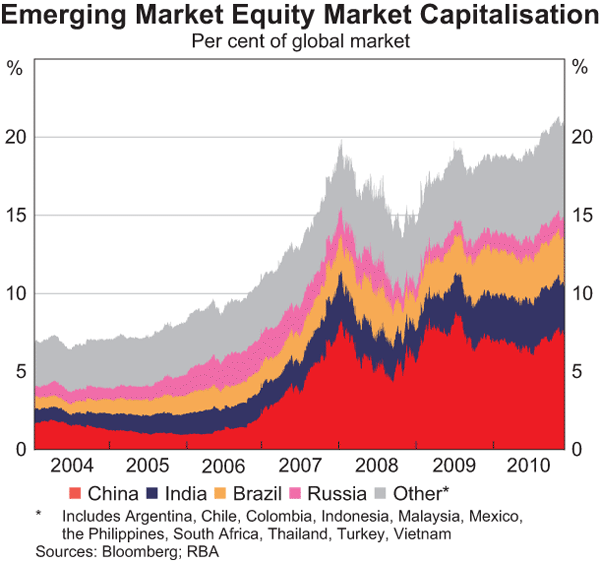
Why Have Emerging Equity Markets Grown?
The increased share of emerging markets in global equity market capitalisation is, in part, due to the rising importance of emerging economies in global economic activity. Emerging economies now account for around one-third of world GDP (at market exchange rates) compared with around one-fifth in the late 1990s. In addition, ongoing financial deepening in many of these countries has seen the size of their equity markets generally grow faster than economic activity (Graph 2). Despite sharp falls in equity prices in late 2008, emerging market capitalisation as a ratio to GDP is generally higher than it was in 2004. The exception is Russia, where market capitalisation remains substantially below its pre-crisis peak owing to the significant influence of energy prices on Russian equities (energy companies make up around half of the market index). India's market capitalisation is now equivalent to around 100 per cent of GDP, comparable to a number of advanced economies (including the United States and Australia).
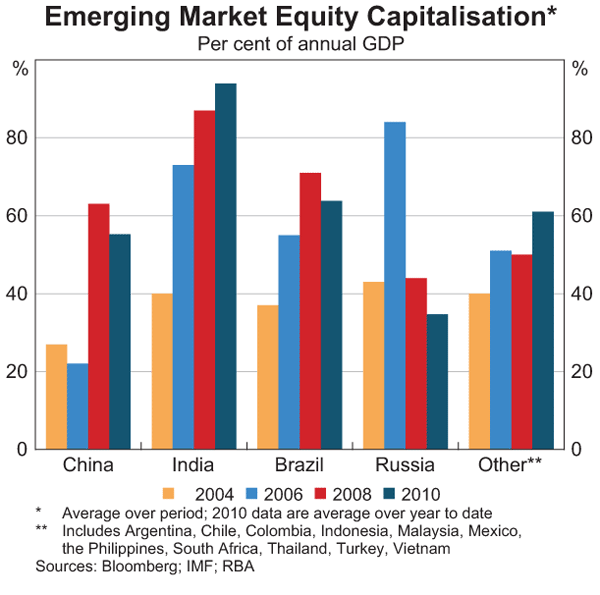
The increased size of emerging equity markets appears to have been supported by a growing domestic investor base, including domestic institutional investors, and increased financial integration with the rest of the world.
The domestic institutional investor base in emerging markets includes pension funds and mutual funds, although these institutional investors are generally small relative to those in advanced economies. While private pension funds' assets in Brazil and India were the equivalent of 17 per cent and 5 per cent of GDP, respectively, in 2007 (the latest available data), they are substantially less than the equivalent OECD-weighted average of 111 per cent of GDP.[1] Brazilian pension funds are permitted to invest up to 50 per cent of their assets in listed stocks, while Indian private pension funds have been permitted to invest a portion of their assets in listed equities only since 2005. In China and Russia, private pension funds appear to be in an even earlier stage of development. However, these countries have public pension funds, with assets equivalent to 5 per cent and 3 per cent of GDP, respectively, in 2007. China's public pension fund, the National Social Security Fund, was permitted to start investing in equities in 2005 and is currently allowed to invest up to 30 per cent of its assets in listed renminbi-denominated ‘A shares’.[2]
The size of mutual funds also varies considerably across emerging markets. Notably, Brazil has one of the largest mutual fund industries in emerging markets, although the funds are predominantly fixed income rather than equities. The mutual fund industry in China and India has continued to develop in recent years although remains small.
The foreign investor base is significant in some emerging equity markets and reflects increased global financial integration over recent decades. Since the mid 2000s, foreign holdings of emerging market equities have generally increased in absolute terms but typically not as a share of market capitalisation (Table 1). Foreign investors are notable participants in the Brazilian and Russian equity markets, with these equity markets generally more receptive to foreign equity investment. Foreign ownership as a share of market capitalisation remains less significant in China and India than in Brazil and Russia, reflecting restrictions on foreign ownership of equities.
| Per cent of GDP | Per cent of market capitalisation |
|||||
|---|---|---|---|---|---|---|
| 2004 | 2007 | 2009 | 2004 | 2007 | 2009 | |
| China | 2.2 | 3.8 | 3.6 | 9.7 | 2.9 | 5.3 |
| India | 6.5 | 9.2 | 7.6 | 11.2 | 5.6 | 7.2 |
| Brazil | 11.6 | 26.6 | 23.9 | 24.3 | 26.0 | 28.1 |
| Russia | 15.1 | 23.9 | 14.1 | 34.5 | 31.0 | 36.8 |
|
(a) Foreign holdings of equity are based on international investment position data Sources: Bloomberg; IMF; Thomson Reuters |
||||||
While most of the larger emerging equity markets have restrictions on foreign ownership of equities, these restrictions were generally eased a little in the years leading up to the financial crisis. However, some countries such as Brazil have more recently expressed concerns over significant foreign investment creating overvalued stock markets and currencies. In October 2009, concerns about capital inflows led Brazilian authorities to introduce a 2 per cent tax on foreigners' purchases of locally issued Brazilian bonds and equities.[3] This was extended in November 2009 by placing a 1.5 per cent tax on purchases of foreign-issued Brazilian equities. The available evidence suggests that portfolio equity inflows fell quite sharply following the extension of the tax to offshore equity issuance (Graph 3).
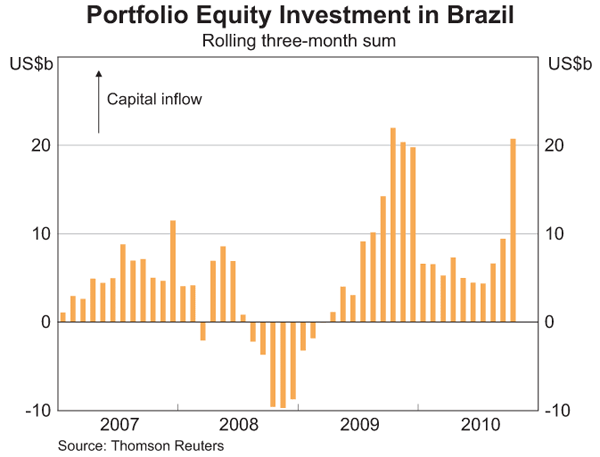
Of the larger emerging equity markets, China has the most restrictive foreign ownership regulations, with only delegated Qualified Foreign Institutional Investors (QFIIs) permitted to purchase renminbi-denominated ‘A shares’. Using a quota system, QFIIs are permitted to make investments in equities and other approved financial instruments up to their respective investment quota, with the 103 QFIIs currently having a combined investment quota of US$30 billion, although less than US$20 billion of that quota was in use towards the end of 2010.
India's foreign ownership regulations are gradually being loosened, with ‘foreign investment ceilings’ rising in recent years to as much as 100 per cent of a listed company's outstanding shares, effectively allowing full foreign ownership of some Indian companies. Some industries, however, still have ownership restrictions.
Consistent with the increased domestic and foreign investor bases, gross equity issuance in emerging economies has increased since the early 2000s (Graph 4). Issuance did, however, fall temporarily as a share of global issuance in 2008. This was particularly true in Brazil and Russia, likely reflecting uncertainty over commodity prices.

Equity issuance by Chinese companies has accounted for a large part of the increase in emerging market equity issuance in recent years. In the mid 2000s, Chinese companies started issuing a substantial amount of equity in Hong Kong. Early on, these issues were predominantly initial public offerings (IPOs), but secondary equity offerings have recently accounted for a significant share. In the late 2000s, issuance by Chinese companies increasingly occurred through stock exchanges in mainland China, with issuance fairly evenly split between IPOs and secondary equity offerings.
Performance of Emerging Market Equities
Emerging market equity prices have experienced much larger swings over recent years than equity prices in advanced economies: pre-crisis growth was stronger; peak-to-trough falls were larger (and those troughs typically occurred earlier); and the recoveries from those troughs have been sharper (Graph 5). These swings have been particularly pronounced in China, where prices more than doubled in the first 10 months of 2007 before falling by around 70 per cent over the following year. Despite a strong rise in Chinese equity prices over the subsequent period, they remain more than 50 per cent below their peak in October 2007.
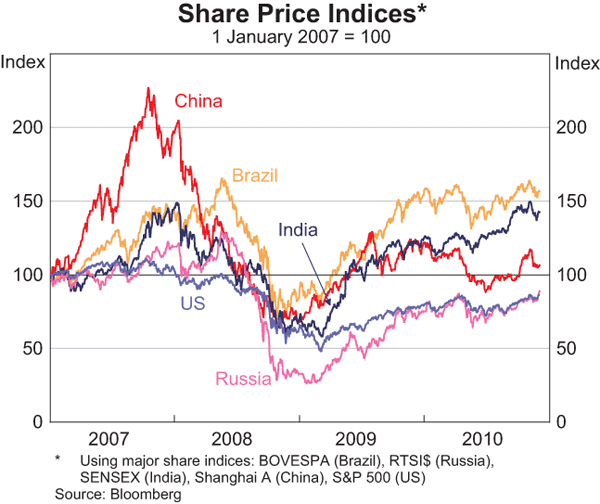
Daily movements in emerging market equity prices have also tended to be relatively volatile (Graph 6). In 2007 and most of 2008, daily volatility in Chinese equity prices was especially high relative to most other markets, partly owing to the uncertainty over the pace of policy tightening in China. Russian equity prices have been particularly volatile in the period since, including a significant spike in late 2008 following the collapse of Lehman Brothers.[4] This largely reflects the relative importance of commodity-related sectors and the significant falls in Russian financial institution equity prices (see below). More recently, volatility in emerging market equity prices has generally moderated as investor confidence has recovered.
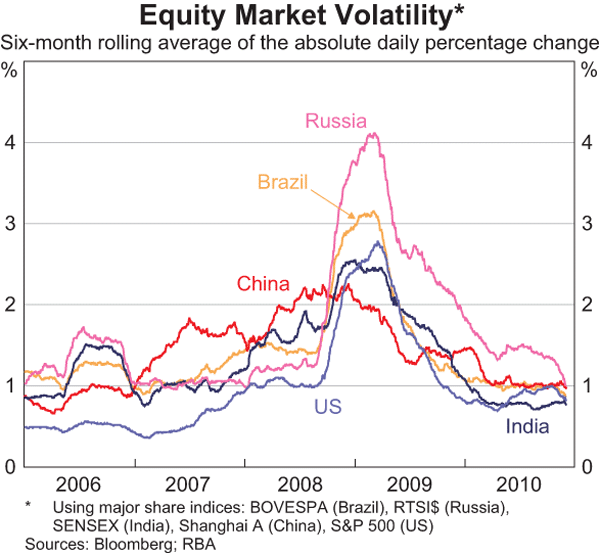
The volatility of daily movements in emerging market equities is in part related to the sectoral composition of these markets. In contrast to stock markets in the United States and Western Europe, equity market capitalisation in the large emerging markets is concentrated in a few sectors. This concentration means that idiosyncratic shocks can lead to significant volatility in the daily movements in broad market indices.
Many emerging market equity indices have relatively large shares in the energy, materials and industrial sectors, in part because of the relatively high shares of industry in many emerging economies (Table 2). In particular, the major equity price indices in Brazil and Russia have very large weights in commodity-related sectors, reflecting the natural resource endowments of these countries. In Brazil, the materials sector, including base metals production, accounts for around 30 per cent of the main equity index. The energy sector in Brazil also represents a large share of market capitalisation at around 15 per cent. In Russia, energy companies account for around half of the major equity price indices. China and, to some extent, India also have relatively large weights in commodities sectors.
| China | India | Brazil | Russia | United States | ||||||
|---|---|---|---|---|---|---|---|---|---|---|
| No of firms | Share Per cent | No of firms | Share Per cent | No of firms | Share Per cent | No of firms | Share Per cent | No of firms | Share Per cent | |
| Index | 844 | 100 | 30 | 100 | 68 | 100 | 42 | 100 | 500 | 100 |
| Energy | 26 | 20 | 2 | 15 | 5 | 16 | 9 | 48 | 39 | 12 |
| Materials | 152 | 10 | 4 | 8 | 13 | 30 | 13 | 21 | 30 | 4 |
| Industrials | 220 | 17 | 4 | 13 | 7 | 6 | 1 | 0 | 58 | 11 |
| Financials | 89 | 34 | 5 | 26 | 6 | 16 | 4 | 20 | 81 | 16 |
| Information technology | 57 | 2 | 3 | 15 | 2 | 3 | 0 | 0 | 75 | 19 |
| Other(b) | 300 | 16 | 12 | 23 | 35 | 29 | 15 | 10 | 217 | 39 |
|
(a) Using major share indices: BOVESPA (Brazil), RTSI$ (Russia), SENSEX
(India), Shanghai A (China), S&P 500 (US) Source: Bloomberg |
||||||||||
In China and India, the financial sector has the largest market capitalisation. In part, this can be explained by the stage of development of these economies, with corporates still relatively dependent on the banking sector for external financing. Interestingly, movements in financials' equity prices in China have little correlation with financials' equity prices in advanced economies and largely reflect domestic developments.
Correlation with Advanced Equity Markets
Emerging market equity prices have tended to be weakly correlated with US equity markets, with the notable exception of Brazil (Graph 7). The high correlation for Brazil partly reflects base metals production being correlated with the growth of industrial production globally (and in the United States). The role of foreign investors in Brazilian equities is also likely to be another factor – as global equity markets fell in late 2008, foreign investors repatriated their investments in Brazilian equities; similarly, as global equity markets rose over 2009, foreign investors increased their investments in Brazilian equities.
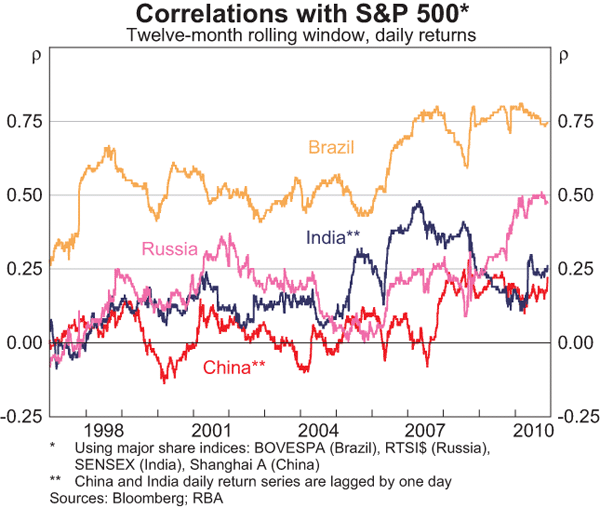
The lower correlation between Chinese and Indian equity prices and those in the United States is partly attributable to the lower level of capital market integration with advanced economies, reflected in the relatively low share of foreign ownership in these equity markets (see above). The lower correlation is also to some extent attributable to the differences between these economies' business cycles and those in advanced economies. More broadly, share markets in China and India appear to be more responsive to developments in domestic financial and economic conditions than global developments.
Valuation of Emerging Market Equities
Based on forward price-earnings (P/E) ratios, the larger emerging equity markets have shown much bigger swings in valuation than have major markets such as the United States (Graph 8).[5] In each of the major emerging markets, equity prices peaked and troughed before the respective turning points in forward earnings estimates (Graph 9).

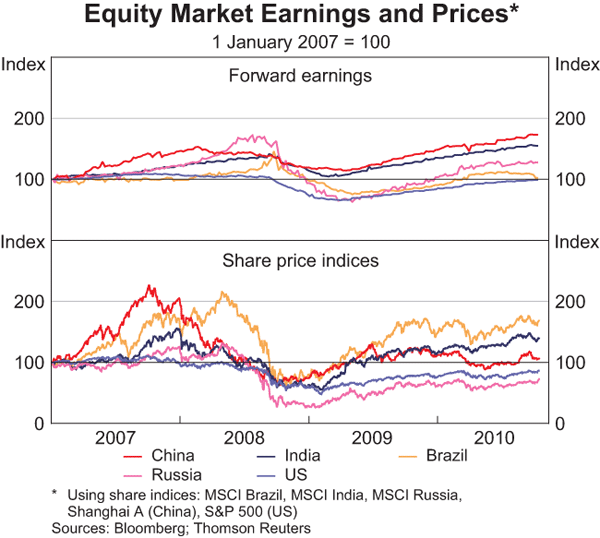
Reflecting the higher growth opportunities that are usually available to businesses in emerging economies, corporate earnings in emerging markets are typically expected to increase faster than in major markets. However, these growth opportunities are often associated with greater risks. The faster expected growth rate is supportive of a higher P/E ratio for emerging market equities than advanced economy equity markets, while the higher risk works in the opposite direction.
Over the past decade, the forward P/E ratio for equities in emerging Asia has typically been higher than in other emerging regions, in part due to the faster rate of economic expansion in emerging Asia. In line with this, Chinese and Indian equities have generally had a higher forward P/E ratio than Brazilian and Russian equities. In recent years, Chinese equities have tended to have the highest forward P/E ratio among these markets. Russian equities, conversely, have had the lowest forward P/E ratio among the larger emerging equity markets, partly reflecting the higher perceived risk of Russian equities.
Forward earnings estimates in China grew by over 50 per cent in 2007, yet this was still well below the pace of growth in Chinese equity prices. This saw China's forward P/E ratio triple between late 2006 and late 2007 to reach particularly high levels. However, China's forward P/E ratio fell over late 2007 and 2008, in part reflecting the realisation that the earnings growth required to justify the relatively high P/E ratio had become unrealistic. Since peaking in late 2007, Chinese equity prices have more than halved. Over the same period, forward earnings estimates have risen by over 20 per cent (although they declined over 2008 and early 2009 before more than retracing this fall). As a result, the forward P/E ratio has now fallen below its long-run average.
Over 2007, forward earnings estimates for Brazilian corporations were largely unchanged, yet equity prices increased by around 50 per cent. As a result, the forward P/E ratio for the Brazilian market rose to be significantly above its long-run average. Since late 2007 equity prices have remained largely unchanged in net terms (they declined sharply over 2008 before more than retracing this fall). Similarly, forward earnings estimates have remained largely unchanged (they also saw large swings). As a result, the Brazilian forward P/E ratio remains above its long-run average.
Looking Forward
Emerging markets' share of global equity market capitalisation has increased in recent decades. Given the ongoing economic convergence of emerging economies with advanced economies anticipated over the coming decades, and the likely further financial deepening in emerging markets, it is widely expected that the emerging market share of global capitalisation will increase further over the longer term. Nonetheless, there may still be large swings in emerging markets' equity prices and share of global capitalisation.
Footnotes
The author is from International Department. [*]
See OECD (2009) for details. [1]
China ‘A shares’ are traded in renminbi and are available only to residents and Qualified Foreign Institutional Investors. China ‘B shares’, listed on the Shanghai (traded in US dollars) and Shenzhen (traded in Hong Kong dollars) exchanges, are available to both foreign investors and residents with a foreign currency deposit account held with a domestic commercial bank. [2]
The tax on bonds now stands at 6 per cent. [3]
Owing to the magnitude of price declines, trading of equities was halted on Russian exchanges numerous times in the months following the collapse of Lehman Brothers in mid September 2008. [4]
Forward P/E ratios are calculated using estimated earnings for the next 12 months sourced from IBES. While these data include a large number of analyst estimates for emerging markets, these may not be as comprehensive as the IBES US data. For example, the S&P 500 forward earnings series is calculated from an average of 7,500 different analyst estimates, while the Shanghai A forward earnings series is calculated from an average of around 1,000 different analyst estimates. Furthermore, IBES forward earnings are earnings excluding extraordinary items. [5]
Reference
OECD (Organisation for Economic Co-operation and Development) (2009), OECD Private Pensions Outlook 2008, OECD, Paris.